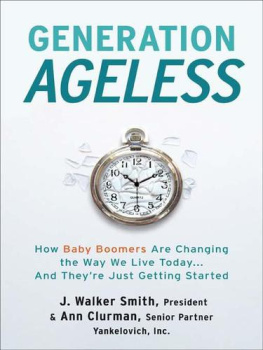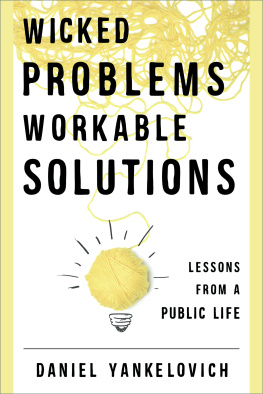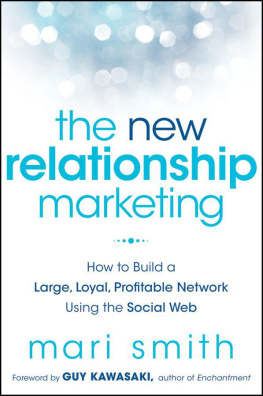J. WALKER SMITH AND ANN CLURMAN
To Ari, the next generation
and
To Joy, together, for generations to come
CONTENTS
PREFACE
I T ALL S TARTED WITH A G IRDLE
S ECTION 1
GENERATIONAL MARKERS
S ECTION 2
G ENERATIONAL M ARKETING
PREFACE
IT ALL STARTED WITH A GIRDLE
Florence Skelly was sitting in her office at Daniel Yankelovich, Inc., one morning in 1968 when she picked up the telephone to take a call that would forever change the way marketers think about their customers and their markets.
Yankelovich was a small research and consulting firm, specializing in the analysis and forecasting of market and social trends that could help businesses better anticipate the needs of their customers. By the late sixties, the firm had begun to notice a distinct transformation in the marketplace. Ongoing strategic research into consumer motivations was turning up some unusual findings. And the firms clients kept saying that something new was happening that they did not yet understand.
Marketers were aware of the winds of change. They were hearing about them from their children and from folk singers on the radio. They were seeing bright young adults dropping out of school to tune in and turn on. They were witnessing a declining interest in white collar careers, accompanied by the rising popularity of experimental lifestyles. They were watching as tradition and authority were flouted and new styles of fashion and homemaking and brand buying were flaunted.
At Yankelovich, we were seeing the first manifestations of these value changes and were learning more about the underlying dynamics as we talked in depth with consumers. New attitudes toward the marketplace were emerging. The traditional conformity and loyalty that had supported the creation of major consumer products brands no longer held. It wasnt clear yet what, if anything, was taking their place. The stage was set for that fateful telephone call.
On the other end of Florences telephone line that day was the president of Playtex telling her that his own wife had thrown away her girdle. She remembers his concern and dismay, as she searched for an answer to the question he put to her: What does this mean for my business?
It wasnt just his wife. Women across the country were throwing away their girdles, and sales at Playtex, the industrys leading manufacturer of intimate wear for women, were, well, sagging. The forces transforming the marketplace for hundreds of products were also bringing change to Playtex.
Questions were being asked in corporate suites across the country as marketers, advertising executives, and operating officers tried to understand what was taking place. Who is out there buying? What are they thinking? Do I have to pay attention to them? How deep do these new attitudes run? Will they last or are they just part of a passing fad?
The initial research for Playtex completed by Florence and her Yankelovich colleagues yielded no easy answers. It started with a traditional look at Playtexs execution of the Four Ps of marketing, but each looked okay. The Product was fine, sturdy with plenty of support. The Price was right, a good value for the money. The Promotion was substantial, with advertising targeting every mother and daughter in the country. And the Places where the product could be found were plentiful, accessible, and attractive. Clearly some other factor was eroding the market.
Then Skelly and her associates began to examine this marketing problem from a different angle. From a generational angle. Anew generation of Americans was coming of age in the late sixties, and they were roiling the waters of the marketplace. Certainly there had been changes and reversals in consumer behavior before, but nothing as deep and perplexing as the kinds that were starting to occur in the sixtieschanges that were rocking the very foundations of the loyalties consumers had for brands. Business leaders felt at sea, unsure of the course they should take.
At Yankelovich, our firms senior consultants examined ways in which this sharp break in attitudes and values was affecting not only Playtex, but many of our other clients, from car manufacturers to travel businesses to spirits companies. They began to see an answer to Playtexs question of what these shifts meant to the bottom line. It had relevance to marketers across the country. The first clue had emerged and as they followed where it led, a whole new way of solving these kinds of marketing mysteries was created.
The new generation was casting old values aside and giving the old generation a fresh outlook on the marketplace. Playtex had built its marketing strategy by the book, focusing on its execution of the Four Ps. But this textbook perspective on the marketplace was too restricted. It had missed something much more elemental: Under the influence of a new generation, traditional assumptions about fashion, appearance, and even virtue were undergoing radical transformation. This new generation of women had entered the marketplace with new opinions about what they wanted to wear. What had occurred was not a failure of marketing execution, but rather a shift in the underlying social values that determined how the new generation would respond to marketing efforts.
This new generation had some distinct ideas: Girdles were not comfortable. They were confining. Stodgy. Old-fashioned. Boomers just coming into their own as a power in the marketplace didnt want to wear them. When mothers tried to pass on esoteric girdle knowledge to their daughters, the daughters werent listening. And in a seismic shift, the new freedoms demanded by the daughters were beginning to influence the buying habits of the mothers.
Skelly counseled Playtex on new strategies that would appeal to the needs and tastes of a new generation of women. For Playtex, this information translated into salvation, giving the company the direction it needed to modernize and better position its product. Stiff bone stays and rubber were abandoned. Softer, lighter, and more flexible fabrics were used. Playtexs sales snapped back.
UNDERSTANDING GENERATIONS
For other marketers the transformation was no less revolutionary. In examining the woes of girdle marketers, our firm had perfected a new tool for investigating and understanding consumer behavior, a tool based on generational marketing.
Generational marketing is a tool with powerful applications. Today, with multiple generations populating the marketplacegenerations with vastly different values, motivations, and life experiencessmart marketers see that the Four Ps alone are no longer sufficient. Understanding generational values and motivations has become essential because each generation is driven by unique ideas about the lifestyle to which it aspires. And its these aspirations that determine the ways consumers spend and save their money. This is very different from the relatively homogeneous consumer marketplace of the immediate post-World War II era, a time when values and motivations were stable and centered around a shared vision of the American Dream.
The story about Playtex reminds us yet again of the first rule of marketingknow your customer. But in practice, this is hard advice to follow. The most difficult part is getting a handle on












